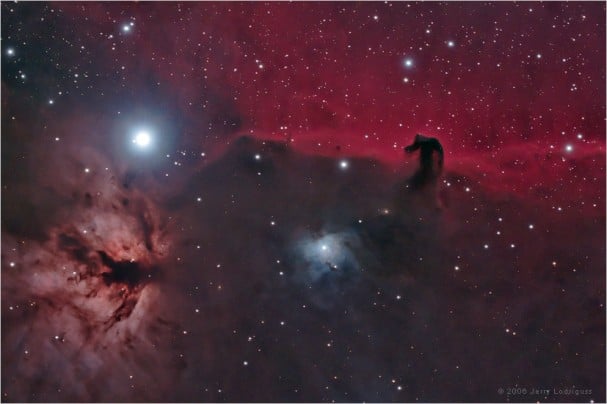Astrophotography is about as niche a market as you can find in photography. Though composed mainly of astronomy enthusiasts, astrophotography may have some sales potential. After all, there are few things as striking as distant galaxies and nebulas to hang on the wall in large format.
However, astrophotography for sale in the printing market is relatively untested and making the images is a complex, time-consuming process. Moreover, the approach to astrophotography is somewhat counterintuitive when compared to typical studio and daylight photography.
“When you make a print, the quality of the print is going to have a direct relationship to the signal-to-noise ratio in the image. If you try to print something with a low signal-to-noise ratio it will look awful. People think when you raise the ISO it makes the image noisier; it doesn’t. The noise is the same. In fact, with digital cameras, and DSLRs specifically, the noise actually goes down when you raise the ISO. The trouble is when people raise the ISO they cut the exposure so you don’t have as much signal. The overall signal-to-noise ratio goes down because you cut the signal, not because you have more noise,” explains Jerry Lodriguss, an expert in the field of astrophotography with 40 years of experience. “A lot of photography websites repeat the misconception that higher ISO means more noise when it really doesn’t. What they mean is that higher ISO means less signal. I used to be a sports photographer at the Philadelphia Inquirer and I used high ISOs every day and those images were noisy. The reason is because I had to shoot at 1/500 to stop the action. If I had shot at 1/60 it would not have been noisy, but it would have been blurry.”
Furthermore, says Lodriguss, telescopes are measured by the size of the aperture, while cameras a measured by focal length, so it can be somewhat confusing when the two are discussed in the same breath since they’re connected during the photo process. The telescope takes the place of the camera lens. A 300mm telescope is not the same as a 300mm lens, for instance, and as Lodriguss puts it, “The aperture is everything in astronomy; that’s what gathers the photons.”
Because the deep space images are so faint, it’s all about collecting photons. Moreover, cameras like Canon’s new EOS 60Da are designed to increase the sensitivity of hydrogen-alpha lines. “Once you get deep into this some of the most beautiful objects in the sky are red emission nebula. The only difference is that the long wavelength filter in front of the sensors is modified to pass more of the hydrogen alpha wavelength, which is 656 nanometers, and that wavelength is the light emitted by red emission nebula, so it makes it more suitable for astronomical purposes. Canon filters out most of that red light in their other cameras because they don’t like to see ruddy complexions in portrait photography,” says Lodigruss.
You can use a “regular” camera for objects within the solar system, especially the moon, but beyond that range it’s time to find a camera, like Canon’s, that can get the most out of deep space objects.
“In astronomical photography, the quality you produce is generally in direct relationship – aside from your skill, equipment and time – to exposure time. The more exposure time collects more photons, and more photons will translate to a higher signal-to-noise ratio, and that’s the defining quality of how good the image is going to be. It’s extremely different than normal daytime photography where you have a lot of light to work with. This stuff is incredibly faint, so it’s not the kind of thing where you can shoot a couple of short exposures, which is why some of the exposures run into the hours,” explains Lodigruss. “I usually break the exposures into sub-exposures. In the days of film, we used to shoot hour-long exposures; with digital cameras you can’t do that. You break them up into a series of shorter exposures and put them together. You might shoot five or ten minute exposures and then shoot 20 or 30 of those and put them together to equal one long exposure.”


